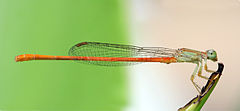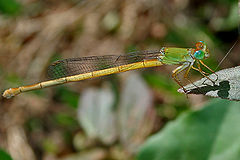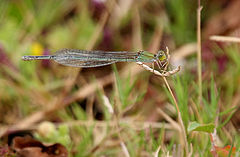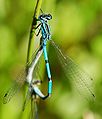- Coenagrionidae
-
Coenagrionidae 
Male Ceriagrion glabrum Scientific classification Kingdom: Animalia Phylum: Arthropoda Class: Insecta Order: Odonata Suborder: Zygoptera Superfamily: Coenagrionoidea Family: Coenagrionidae Genera More than 90 genera are accepted; see text.
The insect family Coenagrionidae is found in the order Odonata and the suborder Zygoptera. The Zygoptera are the damselflies, which although less known than the dragonflies, are no less common. There are more than 1100 species in this family, making it the largest damselfly family. Coenagrionidae has six subfamilies and they are Agriocnemidinae, Argiinae, Coenagrioninae, Ischnurinae, Leptobasinae, and Pseudagrioninae.
This family is referred to as the Narrow-winged damselflies or the pond damselflies.[1] The Coenagrionidae enjoy a worldwide distribution, and are among the most common of damselfly families. This family has the smallest of damselfly species.
More than 90 genera of the family Coenagrionidae are currently accepted.[2]
Contents
Etymology
The name may be derived from Greek coen meaning shared or common and agrio meaning fields or wild.
Characteristics
- Usually with black pattern.
- Their ground color may be green, blue, yellow, orange, or purple.
- Their wings are narrow, usually colorless and clear.
- Wings stalked.
- Two antenodal cross veins.
- Vein M3 arising nearer to nodus than arculus.
Genera
The following is a complete list of genera:
- Acanthagrion
- Acanthallagma
- Aceratobasis
- Aciagrion
- Aeolagrion
- Africallagma
- Agriocnemis
- Amphiagrion
- Amphiallagma
- Amphicnemis
- Amorphostigma
- Andinagrion
- Angelagrion
- Anisagrion
- Antiagrion
- Apanisagrion
- Argia
- Argiagrion
- Argiocnemis
- Archboldargia
- Archibasis
- Austroagrion
- Austroallagma
- Austrocnemis
- Azuragion
- Bedfordia
- Boninagrion
- Bromeliagrion
- Caliagrion
- Calvertagrion
- Cercion
- Ceriagrion
- Chromagrion
- Coenagriocnemis
- Coenagrion
- Cyanallagma
- Denticulobasis
- Diceratobasis
- Dolonagrion
- Enacantha
- Enallagma
- Erythromma
- Helveciagrion
- Hesperagrion
- Himalagrion
- Homeoura
- Hylaeargia
- Hylaeonympha
- Inpabasis
- Ischnura
- Leptagrion
- Leptobasis
- Leucobasis
- Megalagrion
- Melanesobasis
- Mesamphiagrion
- Mesoleptobasis
- Metaleptobasis
- Millotagrion
- Minagrion
- Moroagrion
- Mortonagrion
- Nehalennia
- Neoerythromma
- Nesobasis
- Onychargia
- Oreagrion
- Oreiallagma
- Oxyagrion
- Oxyallagma
- Pacificagrion
- Palaiargia
- Papuagrion
- Papuargia
- Paracercion
- Pericnemis
- Phoenicagrion
- Pinheyagrion
- Plagulibasis
- Proischnura
- Protallagma
- Pseudagrion
- Pyrrhosoma
- Rhodischnura
- Schistolobos
- Skiallagma
- Stenagrion
- Teinobasis
- Telagrion
- Telebasis
- Tepuibasis
- Thermagrion
- Tigriagrion
- Tuberculobasis
- Tukanobasis
- Vanuatubasis
- Xanthagrion
- Xanthocnemis
- Xiphiagrion
- Zoniagrion
Photo gallery
-
Northern Damselfly, Coenagrion hastulatum
References
- ^ Borror, D.J. and White, R.E. (1970). A Field Guide to Insects. Boston: Houghton Mifflin Company. ISBN 0-395-91171-0.
- ^ Integrated Taxonomic Information System (2007). Coenagrionidae, retrieved November 4, 2007.
External links
See also
- List of damselflies of the world (Coenagrionidae)

This article related to damselflies is a stub. You can help Wikipedia by expanding it.







